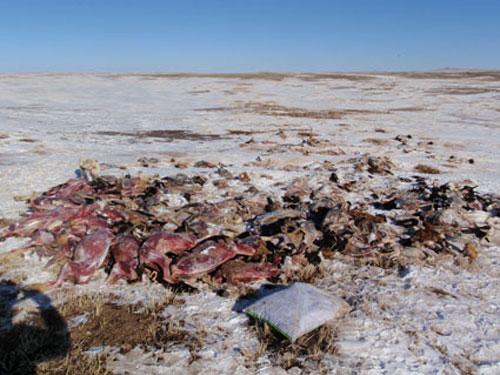Энэ 7 хоногт
Mongolia’s Animal Disaster
A dzud, an extreme winter phenomenon with temperatures as low as -52.6 degrees F, has caused significant suffering and death to approximately 3.4 million livestock in Mongolia, to date.

A dzud, an extreme winter phenomenon with temperatures as low as -52.6 degrees F, has caused significant suffering and death to approximately 3.4 million livestock in Mongolia, to date.
Damien Woodberry, a veterinarian with The World Society for the Protection of Animals' (WSPA) disaster response team, recently visited Mongolia, where he worked with WSPA's member society, the Cambridge Mongolia Development Appeal (CAMDA), to deliver emergency aid to animals.
"The landscape is literally littered with dead animals--cows, sheep, goats, yaks, horses and camels. It is horrific," said Woodberry. "Most the herders' gers or yurts--semi-permanent tents that they live in--have large piles of dead animals next to them. The ones left alive are sick or so weak they barely move when you approach, and all are extremely thin."
Cold weather happens every winter, but this Mongolian dzud is a combination of events causing a far higher rate of animal death:
Summer droughts: These prevented many herders from stockpiling sufficient hay and fodder reserves to last their animals through the winter.
A higher-than-usual winter snow fall: Animals couldn't access what pastures remained and herders' efforts to feed with their own stocks was hampered.
Extreme cold: Snow on the ground turned to ice, making it impossible for animals to use what little pasture had been available. The animals, who already suffered from malnutrition, then became extremely vulnerable to hypothermia.
The last dzud in 2001 killed about 11 million animals. However, experts estimate this dzud will be worse. With no relief until at least May, possibly even as late as June. A total loss of 4-5 million animals is expected by spring. By the end of the disaster, an estimated 20 million animals could have died.
"I have been a herder since 1960 and have never seen a winter as cold as this one," said Mr. A. Lkhagvasurn, Adaatsag Soum, Dundgovi Aimag. "My two neighbours have already lost all their animals and if I lose all mine, I do not know what I will do."
"I saw family after family in tears at the plight of their animals and the very uncertain future ahead of them. Many herders have lost 50-60 percent of their herds, while some have lost their entire herd and, with it, their livelihood. A humanitarian disaster is waiting," Woodberry said.






